How to Build a Culture of Inclusion at a Time of Backlash


Cynthia Owyoung knows diversity because she has lived and breathed it her whole life. She is the daughter of immigrants in San Francisco’s Bayview District, a primarily African-American neighborhood. Her father served in the Air Force. One of her brothers is gay; another brother is developmentally disabled. When that brother lost his job during the economic downturn of the early 2000s, Owyoung was responsible for finding him a new job. The challenge inspired her to leave marketing for work in diversity, equity, and inclusion (DEI) to break down barriers for people like her brother experiencing the same thing.
“DEI was kind of the natural evolution of my entire life experience,” said Owyoung, “and bringing that to bear to help people thrive in their workplaces, no matter where they come from or what background or abilities they might have.”
Owyoung is now the author of All Are Welcome: How to Build a Real Workplace Culture of Inclusion That Delivers Results. She spoke in a fireside chat titled, “How to Build a Culture of Inclusion at a Time of Backlash,” with David Thigpen, director of the University of California, Berkeley undergraduate journalism program. The talk happened onstage at From Day One’s San Francisco conference in Mission Bay.
As a field, DEI has advanced in the last 20 years. When Owyoung first became involved, DEI was mainly about affirmative action and compliance programs. “People were doing it because the government said you had to,” she said. Then DEI started to evolve into more of a business strategy, as people became aware that more diversity could help drive innovative problem-solving, better decision-making, and an improved ability to serve their marketplace and customers.
In recent years, DEI initiatives have expanded as a greater number of leaders realized that it’s not just good for business, there’s also a wider moral imperative to correct social inequities beyond the workplace.
“We all want to live in a more just world, and companies are now more and more being seen as places that can affect some of that change,” said Owyoung. “Because we have so much more distrust in government and other types of institutions that would normally be playing that role, there’s a grounded expectation of companies and organizational leaders really driving in this area.”

Owyoung acknowledged that companies are still struggling with balancing those things, especially when talking about DEI can be so divisive. And everybody has differing opinions on how to do it well.
“A lot of companies make this mistake of focusing only on representation numbers,” she said. “Often that translates into, ‘I have to hire more people from different backgrounds into my company and so let’s build up the talent pipeline [and] our recruiting organization to do that.’ And what ends up happening is that they haven’t done the foundational groundwork on their culture to make sure that it’s inclusive.”
An inclusive company culture connects to people of all backgrounds and experiences and creates a working environment in which employees want to stay. “Staying usually involves being developed,” said Owyoung. “Seeing your career grow, seeing opportunities for yourself, seeing role models of yourself in the upper levels of the company. And oftentimes companies fall down on that part.”
Companies lack inclusivity when they don’t invest in employee development and don’t pay attention to who’s getting promoted or picked for leadership opportunities. They can also fail to acknowledge whether employees feel a strong sense of belonging or if they’re feeling alienated because they’re the only one who is a person of color on a team.
“All of that ends up creating this revolving door where you might be bringing people in, but they’re leaving at the same rate,” Owyoung said. “So you’re not moving your representation numbers at all. If you’re not focusing on all those other aspects of the culture, and that has to be tied to your values as a company, then you’re not gonna make progress.”
Previously companies focused on DEI programs and partnerships with organizations to provide a sourcing pipeline for people of diverse backgrounds. “And that’s all great and necessary,” said Owyoung, “but not enough.” Companies must now take a systematic approach to fix the problem.
“You’re looking at what are the institutionalized structures that are reinforcing our current biases and stereotypes and the status quo,” she said. “Those are the things that have to be dismantled. When you think about hiring, promotion, succession planning, talent review—any kind of talent process inside your company—attacking every step in that process becomes necessary to be more inclusive. Changing structures like that are how you drive change and progress in your organization.”
Samantha Campos is a freelance journalist who’s written for regional publications in Hawaii and California, with forays into medical cannabis and food justice nonprofits. She currently resides in Oakland, California.
The From Day One Newsletter is a monthly roundup of articles, features, and editorials on innovative ways for companies to forge stronger relationships with their employees, customers, and communities.